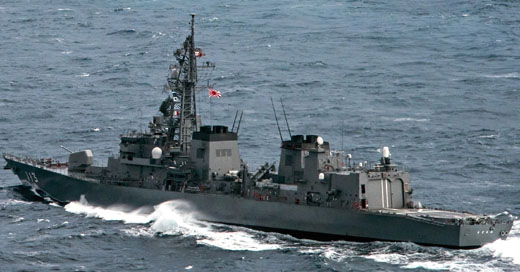by WorldTribune Staff, February 3, 2020
Japan has dispatched a helicopter destroyer to the Middle East to safeguard the nation’s oil supplies, Prime Minister Shinzo Abe said.
The Takanami-class destroyer left its port near Tokyo on Feb. 2 and is tasked with protecting merchant ships and oil tankers passing through the Gulf of Oman. About 90 percent of Japan’s oil is moved through the gulf.

Japan in October declined to join a U.S.-led coalition to protect shipping in vital commerce lanes in the Middle East, instead saying it would send its own vessels to ensure safe delivery of oil to Japan.
U.S. President Donald Trump accused Iran of carrying out June 13, 2019 attacks against two oil tankers in the Gulf of Oman, including a Japanese vessel. No one was hurt in the attack, but the ships suffered damages.
Related: Japan follows U.S. lead, announces space force, January 28, 2020
Several incidents in and around the Gulf of Oman, which sees around one-fifth of international oil shipments, were reportedly sparked by Iran. Teheran denied any involvement in attacks on tankers.
Radio Free Europe/Radio Liberty noted in a Feb. 2 report that Japan, which is heavily reliant on the import of oil products, “has maintained relatively good relations with Teheran and expressed reluctance to join the U.S.-led force.”
Chief Cabinet Secretary Yoshihide Suga said last year that Tokyo would cooperate with Washington in efforts to protect oil tankers amid a series of attacks the West and Arab allies blamed on Iran.
“We won’t join the United States, but will cooperate closely with them,” Suga told a news conference. “Self-Defense Force assets will ensure the safety of vessels related to Japan.”
“Peace and stability in the Middle East is extremely important for the international society, including Japan,” he added. “After we studied comprehensively what measures can be most effective, we have decided to pursue our own measures separately.”
The destroyer and its 200-member crew will operate with two P-3C maritime patrol aircraft to guard ships heading for Japanese ports, Japanese officials said.
While the Abe government said it was prepared to authorize force to protect ships in danger, some analysts noted that Japan’s war-renouncing constitution written after World War II forbids the use of military force to settle international disputes.
Intelligence Brief __________ Replace The Media
